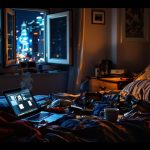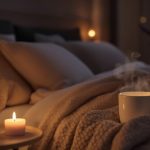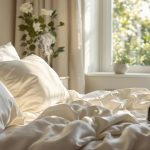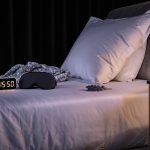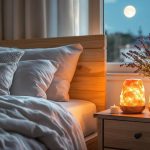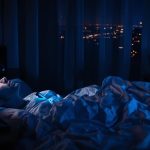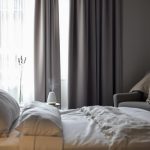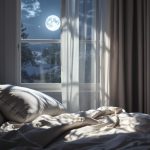
Technology plays a significant role in altering your sleep hygiene habits. Exposure to blue light from screens suppresses melatonin, disrupting your sleep pattern and making it difficult to fall asleep. Engaging with interactive devices at bedtime delays sleep onset and affects sleep quality. The constant focus on sleep metrics from trackers can increase anxiety and shift your attention from actual sleep health. To improve sleep, set boundaries for device use, reduce blue light exposure, and switch to calming, passive activities before bed. By exploring further, you’ll discover effective strategies to enhance your sleep hygiene and achieve restful nights.
Blue Light and Sleep Disruption
In today’s digital age, blue light exposure has become an unavoidable part of evening routines, and it’s a significant culprit in disrupting sleep patterns. You’re probably aware that this isn’t just about staying awake longer; it genuinely affects your sleep quality. By suppressing melatonin, blue light impacts your ability to fall asleep, making you feel less drowsy at night. Your brain gets tricked into thinking it’s still daytime, throwing off your natural sleep-wake cycle, or circadian rhythm. Chronic exposure may even lead to insomnia and other sleep disorders, making it even more crucial to address this issue. Emitting from electronic devices like smartphones, tablets, and computers, blue light is a powerful force that can delay melatonin secretion. Research shows that even small amounts of blue light at night can significantly disrupt melatonin production and biological clock functions. Even the dimmest blue light can interfere with your body’s internal clock, reinforcing the idea that liberating yourself from these artificial emissions is essential for better sleep quality. Retaking control means implementing strategies to reduce blue light effects—such as turning off devices before bed, using blue light filters, and wearing blue light-blocking glasses.
Interactive Devices and Sleep Quality
Blue light’s impact on sleep is just one aspect of how technology affects sleep hygiene; the role of interactive devices in shaping sleep quality merits attention as well. You might notice that using your phone or playing video games before bedtime leaves you tossing and turning longer than you’d like. Engaging in mindful eating techniques throughout the day can also positively influence nighttime rest, minimizing the negative effects of screen usage before bed. Interactive screen effects are powerful; engaging with these devices within an hour of sleep can delay your sleep onset by as much as 30 minutes. Even during the day, each hour spent on your devices can chip away at your sleep, stealing about 10 minutes per hour from your nightly rest. Research has shown that avg sleep duration for adolescents is approximately 7.8 hours per night, but interactive screen use can significantly reduce this. Embracing freedom and flexibility in your life doesn’t mean compromising on good sleep. Frequent screen use, whether chatting with friends or battling in online games, cuts your sleep duration and affects your health. The sleep duration impact is real, often pushing bedtime further back and leading to restless nights. It’s not just about losing sleep; reduced sleep quality can trigger health issues, including obesity and mental health challenges. Break free from the cycle by setting boundaries for interactive devices, especially before bed. You’ll gain better sleep and enhance your daily power to explore everything life offers.
Melatonin Suppression by Screens
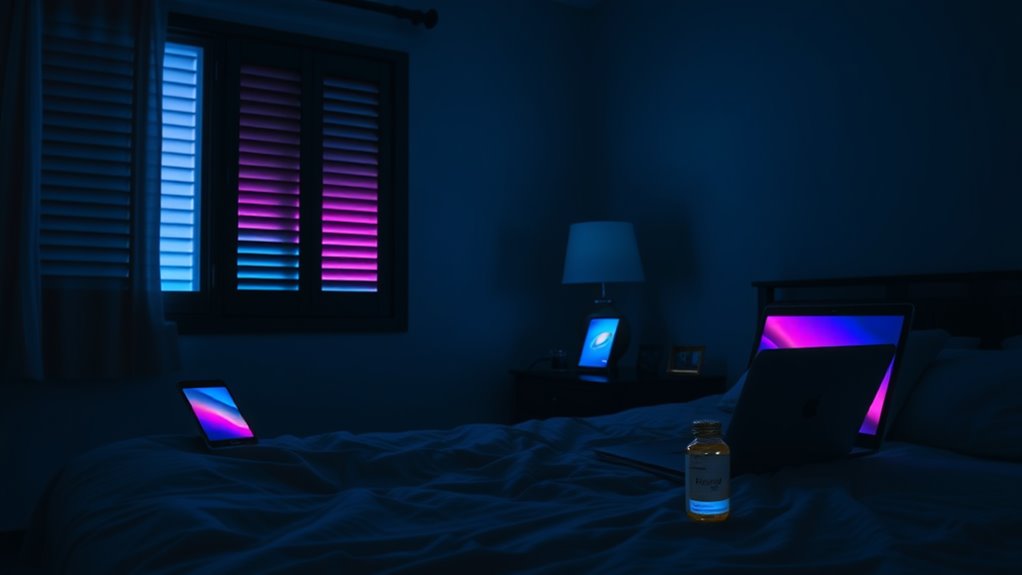
You mightn’t realize it, but your nighttime screen habits can greatly disrupt your sleep cycle. Screens emit blue light, which suppresses melatonin production by stimulating areas of your brain that keep you alert and awake. Unlike other light, blue light has the most potent effect, tricking your brain into thinking it’s daytime and making it tough to fall asleep. Even if the lighting seems dim, the screen effects linger, reducing melatonin levels and altering your sleep quality considerably. Let’s not forget how these screen effects might chain you to unhealthy routines. Melatonin suppression isn’t merely about losing a little shut-eye; it’s linked to significant health implications like increased risks of cancer, diabetes, and heart disease. Not to mention, ongoing exposure also can contribute to metabolic disorders and mental health issues such as depression. This lack of quality sleep spills into your daily life, impairing concentration and clouding your ability to perform tasks. But there’s hope! Liberate yourself from these adverse effects by reducing screen time a couple of hours before bed, using devices’ night modes, or donning blue-light blocking glasses. Taking control means reclaiming your nighttime peace and health. Furthermore, insufficient water intake can exacerbate fatigue and negatively impact energy levels, highlighting the importance of hydration for overall well-being.
Circadian Rhythm Shifts
Several factors contribute to circadian rhythm shifts, and evening light exposure is one of the most significant. Bright screens from smartphones, tablets, and computers are the main culprits, emitting blue light that disrupts your body’s natural sleep-wake cycle. This interference occurs because blue light is notorious for suppressing melatonin production, which is essential for initiating sleep.
When your brain is exposed to bright lights in the evening, including household LEDs, it becomes more alert, making it harder to drift into restful sleep and maintain sleep consistency. Incorporating mindfulness practices can help manage the stress often linked to disrupted sleep patterns, fostering a more peaceful state of mind.
To free yourself from these shackles of sleep disruptions, consider reducing evening exposure to bright lights. Opt for warm lighting solutions, which can help conserve your circadian rhythm and remind your body when it’s time to unwind.
It’s liberating to know that small changes can have profound impacts on your sleep health. Establishing rules around screen time—like enforcing a “no screen” policy an hour before bed—can dramatically enhance the quality and duration of your sleep.
It’s not just about getting enough rest tonight; it’s about setting a foundation for a lifetime of better sleep and heightened well-being.
Sleep Trackers and Anxiety

When it comes to modern sleep aids, sleep trackers are a double-edged sword that might be doing more harm than good. You might think they’re helping you achieve perfect sleep, but the constant focus and pressure on getting ideal sleep scores can actually ramp up your sleep anxiety. Instead of relaxing into slumber, you find yourself worrying about every missed hour or restless minute, turning sleep into a performance.
This obsession isn’t just tiring—it’s exhausting, as anxiety about hitting those numbers can make falling and staying asleep even harder.
Your dependency on these trackers can wind up altering your natural sleep behavior. They can trick you into staying in bed longer than needed, or force you to sleep when you’re not really tired, disrupting your body’s natural rhythms. Ignoring your own body’s signals due to the data from an often-inaccurate device isn’t truly helpful.
Furthermore, the emotional rollercoaster that can come from daily sleep analysis—especially when confronted with flawed data—only increases distress and impacts your mood negatively. Rather than finding freedom in restful nights, tracker dependency could shackle you to more stress and less sleep.
Technology-Induced Sleep Disorders
You might notice that using screens right before bed seriously affects your sleep by interfering with melatonin production and causing insomnia.
This blue light exposure mimics daylight and disrupts your circadian rhythms, making it tough to wind down.
On top of that, tracking your sleep with technology can lead to anxiety that further hinders your ability to fall asleep and reduces overall sleep quality.
Blue Light and Insomnia
The pervasive glow of screens has a profound impact on sleep hygiene, primarily by interfering with your body’s natural production of melatonin. Blue light effects result in the suppression of melatonin levels, disrupting your sleep-wake cycle. This disruption makes you feel less sleepy, increasing your alertness just when you’d rather drift off peacefully.
With Harvard research indicating blue light suppresses melatonin more than any other light, your circadian rhythm can feel like it’s being held hostage by your devices.
You’re surrounded by sources of blue light everywhere: smartphones, tablets, computer monitors, and even the LED lights you use at home. This exposure, particularly in the evening, delays melatonin release, making it harder to fall asleep and leaving you struggling to get quality rest.
It’s like a stealthy thief, robbing you of critical sleep duration and satisfaction.
Liberate yourself by reclaiming control over your sleep. Ditch screens a few hours before bed, or at least activate blue light-filtering settings on your devices.
Alternatively, wear blue light-blocking glasses or opt for warm lighting. By doing so, you’re not just improving your sleep quality; you’re stepping towards a more liberated, well-rested you.
Screen Time Disruptions
While blue light’s effects on melatonin capture attention, it’s not the only way technology disrupts sleep. Your screen habits, like texting or playing video games before bed, can delay sleep onset and fragment your rest. Over 70% of Americans with sleep disorders use technology at bedtime, reducing average sleep to just 5 hours.
It’s not just the blue light assaulting your senses—it’s the engaging content that heightens your alertness right when you’re trying to wind down. Devices like smartphones, tablets, and gaming consoles amplify sleep disruption, especially when used in dark rooms.
Interactive activities are more disruptive than passive ones like watching TV. The stimuli from sounds, vibrations, and light further intrude on your path to restful sleep. Younger folks and urban residents face heightened risk, with technology more prevalent among under-25s and city dwellers.
Screen time before sleep doesn’t only rob you of shut-eye; it’s linked to serious health issues like heart disease, high blood pressure, and obesity. If you’re yearning for liberation from restless nights, consider a digital detox.
Say goodbye to screens at least an hour before bed and claim the freedom of a good night’s sleep.
Sleep Trackers’ Anxiety
Sleep trackers, touted as digital allies for better rest, can ironically induce sleep anxiety and distort your perception of restfulness. Sleep tracker reliability often falters, especially with deep sleep accurately identified merely 59% of the time. You might find yourself fixating on these numbers, hoping to improve them, only to spiral into sleep anxiety. The focus shifts from genuine sleep health to an unhealthy fixation on metrics, leading you to seek perfect data over restorative sleep.
| Common Issues | Impact on Sleep | Sleep Anxiety Management |
|---|---|---|
| Imprecise data | Fatigue | Mindfulness techniques |
| Misplaced sleep goals | Extra time in bed | Relaxation before sleep |
| Psychological impact | Feeling unrefreshed | Cognitive Behavioral Therapy |
| Technology obsession | Stress and anxiety | Limit technology use |
| Overreliance | Avoids clinical help | Consult sleep specialists |
Relying too heavily on these devices might mean ignoring symptoms that diverge from what your sleep tracker reports. This discrepancy can lead to confusion and stress, exacerbating sleep issues instead of solving them. Liberate yourself from the tyranny of technology by embracing authentic sleep patterns and prioritizing mental well-being. Remember, achieving genuine rest doesn’t require perfect metrics. Seek sleep anxiety management methods that empower you to break free from the shackles of numbers.
Smart Devices for Sleep Monitoring
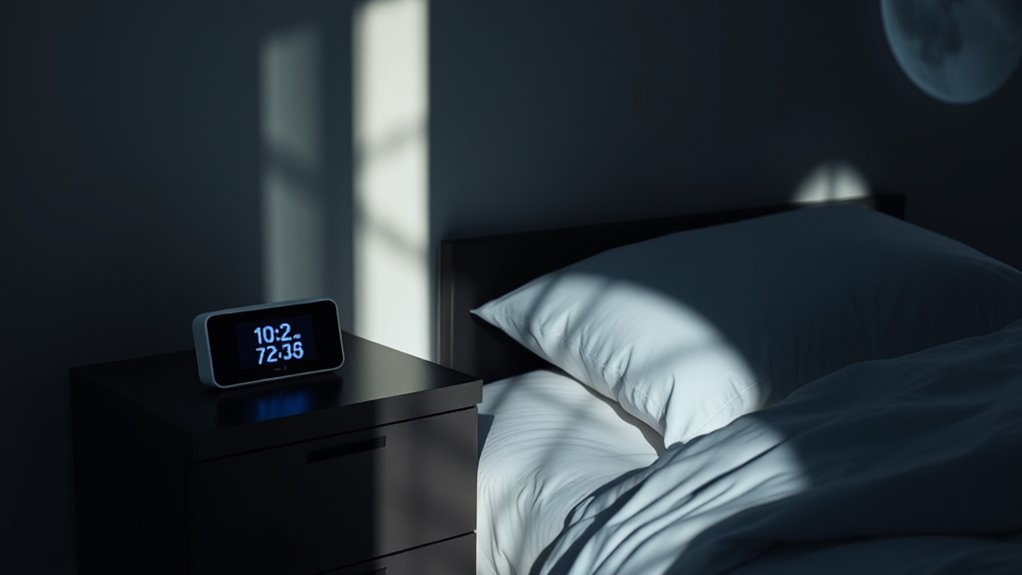
Diving into the world of smart devices for sleep monitoring reveals a fascinating blend of technology and personal health insights. You can explore sleep tracker accuracy as these devices rival traditional methods like actigraphy. They excel at detecting sleep periods but can overestimate total sleep time. Still, they provide an accessible alternative to polysomnography. Imagine customizing your sleep device to monitor various sleep phases and environmental factors like light and temperature, offering a tailored analysis just for you. These devices do more than just track—their capabilities stretch into the domains of smart alarms and sleep coaching. They help you understand sleep efficiency, latency, and restfulness, offering real-time feedback via easy-to-use apps. With a smartwatch or wearable, you don’t just monitor sleep; you integrate it into your lifestyle, making liberation from sleepless nights a tangible goal. Regular exercise contributes to better sleep patterns and serves as a complement to sleep monitoring technologies, enhancing overall sleep quality. The sleep monitoring market is booming, projected to leap from USD 22.97 billion in 2024 to USD 104.14 billion by 2034. This growth is driven by advancements in AI and machine learning, equipping you with cutting-edge sleep insights. Smart home integration and mobile app connectivity add layers of convenience and control, empowering your nightly routine.
Passive Technology and Sleep Routines
Have you ever wondered how the passive use of technology might affect your sleep routines? It turns out passive activities like watching a movie or listening to calming music can be liberating, freeing you from the constant interaction devices often demand. These activities typically involve less stimulation than their active counterparts, like texting or gaming, making them ideal for your bedtime routines.
While passive technology use doesn’t greatly impact sleep onset in comparison, it’s easy to get lost in a thrilling TV series or engaging podcast, delaying the time you turn in.
To prevent disruption of sleep, embrace tech in moderation. Integrate passive activities into your bedtime without letting them steal precious rest. Set your devices to nighttime mode and dim screen brightness to promote relaxation and signal your body that it’s time for sleep. Consistent routines, intertwined with tech, remind you to pause.
Aim for serene, screen-free moments in your sanctuary of sleep. Replace excess screen time with soothing pursuits like reading or playing music softly. Your freedom to unplug embraces the liberation of better sleep, setting the stage for restful nights and vibrancy in every new day.
Reducing Blue Light Exposure
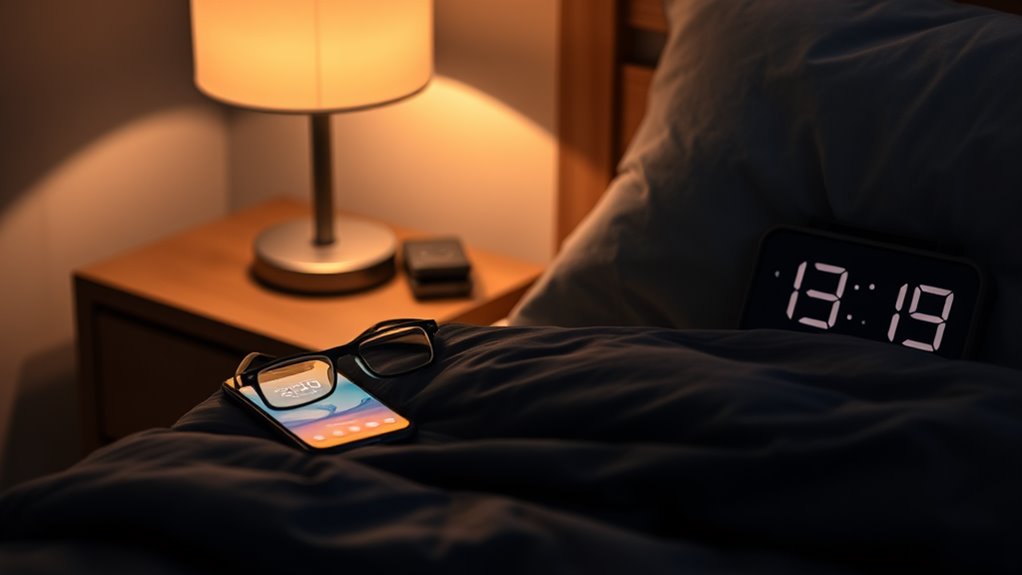
Blue light exposure from electronic devices and artificial lighting plays a significant role in disrupting sleep patterns. Whether you’re glued to your smartphone, immersed in a game, or just winding down with some TV, you’re likely exposing yourself to wavelengths that suppress melatonin production, the natural sleep hormone. It tricks your brain, making you feel more awake when you should be unwinding, disrupting your circadian rhythms and decreasing sleep quality. The outcome? Grogginess and health risks like mood disorders and metabolic issues.
Here are some tactics to liberate your sleep from the blue light trap:
| Source | Blue Light Effect | Screen Time Management Tip |
|---|---|---|
| Smartphones | Suppresses melatonin | Use blue light-filtering apps |
| Computer Monitors | Increases alertness | Adjust to night mode or dark mode |
| Tablets | Disrupts circadian rhythms | Limit usage 2-3 hours before bed |
| TV | Reduces sleep quality | Turn off at least two hours before |
| Indoor Lighting | Impacts mood and health | Switch to red or dim lighting |
Creating Technology-Free Bedtime
You can improve your sleep hygiene by reducing evening screen time and establishing device-free zones.
Start by setting boundaries for when and where you use your electronic devices, making areas like the bedroom a sanctuary for rest.
Creating these habits can help you unwind faster and promote a more restful sleep experience.
Reducing Evening Screen Time
Creating a technology-free bedtime routine can greatly enhance your sleep quality by reducing evening screen time. When you embrace screen free evenings, you reclaim control over your sleep. The glow of screens can suppress melatonin production, a natural hormone vital for quality rest. By shifting to bedtime rituals like reading a printed book or journaling, you allow your body’s sleep-wake cycle to recalibrate.
Interactive devices like smartphones and tablets, especially when used for gaming or messaging, can keep your mind too alert. These activities may extend the time it takes to fall asleep and cut into your restorative sleep stages. Opt instead for passive activities that soothe and unwind your mind. You’ll be amazed at how quickly you drift into restful slumber.
Try adopting proactive strategies like setting an alarm to remind yourself to power down devices an hour before bed. Limit bright screens by enabling night modes and dimming brightness. Red filter apps can also be beneficial, maintaining the balance of melatonin.
Consciously crafting a screen-free environment guides your body towards a smoother, undisturbed sleep, offering a sense of liberation from technology’s relentless grip on your evenings.
Establishing Device-Free Zones
In establishing device-free zones, particularly in your bedroom, you’ll find a renewed sense of tranquility and better sleep quality. By removing electronics, you reclaim the bedroom sanctity, creating an oasis away from the constant buzz of notifications.
Designate an area outside the bedroom to charge and store your devices overnight. This simple shift highlights the device free advantages, making your room a true refuge for restful sleep.
Opt for a basic alarm clock instead of a smartphone to keep nighttime screen temptation at bay. A dark, quiet, and cool environment further nurtures your sleep-welcome atmosphere.
Set firm boundaries with friends, family, and work, clarifying your new device-free commitment. Choose not to respond immediately to messages and calls during your bedtime hours.
Stick to consistent sleep and wake times to align with your body’s natural rhythms. Incorporate calming activities like reading or stretching into your routine, signaling to your body it’s time to wind down.
Adopting the “Do Not Disturb” mode will preserve your peaceful night, while placing devices out of reach guarantees you don’t disrupt your newly achieved sanctuary. Your liberated nights await—embrace this empowering shift.
Professional Advice on Sleep Hygiene
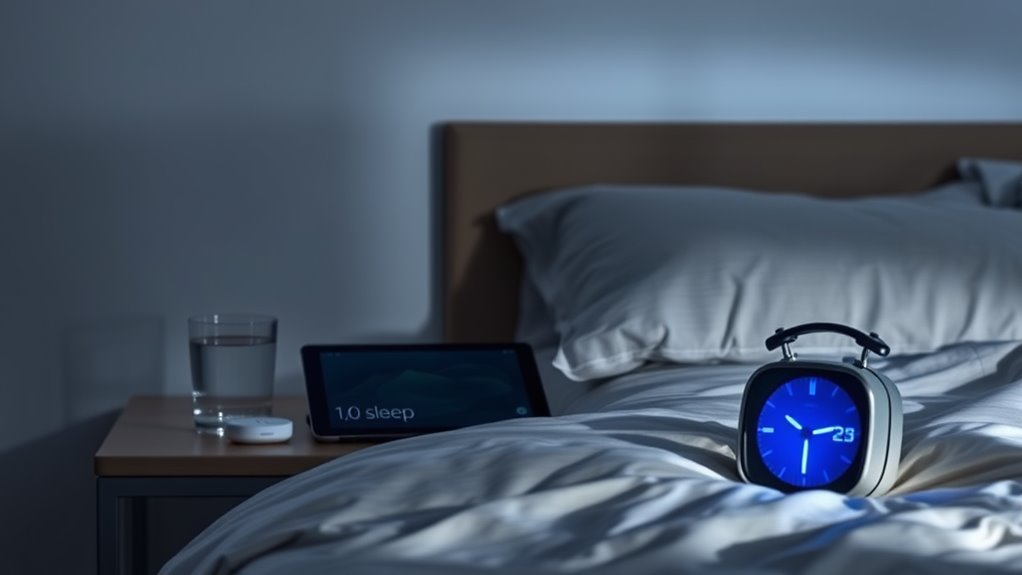
For those seeking to improve their sleep hygiene, professional advice often centers on moderate technology use and fostering a conducive sleep environment.
The impact of technology can’t be ignored—screen time before bed can delay sleep by tricking your body into thinking it’s still daytime due to blue light emission. Experts recommend limiting interactive tech use, such as gaming or texting, which causes increased alertness, delaying bedtime.
To mitigate these effects, consider using nighttime modes and blue light filters, but remember they aren’t foolproof solutions.
Creating a sleep-friendly environment is just as important. Keep your bedroom dark, quiet, and cool.
Using smart lighting systems controlled by apps or voice assistants can help achieve ideal conditions. To reinforce the bed-sleep association, store devices away from the sleeping area, and consider using smart mattresses and bed sensor pads to monitor and adjust sleep settings like temperature.

